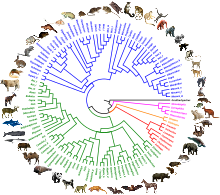Laurasiatheria
| Laurasiatheria Temporal range:
| |
|---|---|

| |
| From top to right: Artiodactyla and Perissodactyla , comprising Laurasiatheria.
| |
| Scientific classification | |
| Domain: | Eukaryota |
| Kingdom: | Animalia |
| Phylum: | Chordata |
| Class: | Mammalia |
| Magnorder: | Boreoeutheria |
| Superorder: | Laurasiatheria Waddell et al., 1999[1] |
| Subgroups | |
| |
| Synonyms | |
| |
Laurasiatheria (presence/absence data. The superorder originated on the northern supercontinent of Laurasia, after it split from Gondwana when Pangaea broke up.[1] Its last common ancestor is supposed to have lived between ca. 76 to 90 million years ago.[6][7]
Etymology
The name of this superorder derives from the theory that this group of mammals originated on the supercontinent of Laurasia.[1] In contrast, extinct primitive mammals called Gondwanatheria existed in the supercontinent of Gondwana.
Classification and phylogeny
History of phylogeny

Uncertainty still exists regarding the
euungulates form a clade Scrotifera, indicating that Eulipotyphla might be the sister group to all other Laurasiatheria taxa.[10][11]
Laurasiatheria is also posited to include several extinct orders and superorders. At least some of these are considered
paraphyletic
assemblages, or to be composed of mammals now understood not to be laurasiatheres at all.
- placental eutherians)
- Creodonta (order closely related to Carnivora, now polyphyletic and split in two orders: Hyaenodonta and Oxyaenodonta)
- Dinocerata (natural order suggested to be closely related to ungulates)[12]
- sister taxon to perissodactyls, though in recent studies this clade was found to be polyphyletic)[13]
- Mesonychia (natural clade, though several members, such as genus Andrewsarchus, are now thought to belong in other groups)
Taxonomy
- Superorder: Laurasiatheria (Waddell, 1999)
- Clade: Scrotifera (Waddell, 1999)
- Order: Eulipotyphla (Waddell, 1999) (true insectivores)
See also
- Mammal classification
- Boreoeutheria
- Gondwanatheria – a clade of mammaliaformes named after supercontinent of Gondwana
References
- ^ PMID 12078634.
- ^ Arnason U., Adegoke J. A., Gullberg A., Harley E. H., Janke A., Kullberg M. (2008.) "Mitogenomic relationships of placental mammals and molecular estimates of their divergences." Gene.; 421(1–2):37–51
- PMID 10468596.
- OCLC 708357723.
- S2CID 206544776.
- PMID 22628470.
- PMID 21900649.
- S2CID 22900642.
- PMID 24184098.
- PMID 23813979.
- ^ Burger, Benjamin J., (2015.) "The systematic position of the saber-toothed and horned giants of the Eocene: the Uintatheres (order Dinocerata)", Utah State University Uintah Basin Campus, Vernal, Utah
- ISSN 2296-701X.
Further reading
- Murphy, William J.; Eizirik, Eduardo; O'Brien, Stephen J.; Madsen, Ole; Scally, Mark; Douady, Christophe J.; Teeling, Emma; Ryder, Oliver A.; Stanhope, Michael J.; de Jong, Wilfried W.; Springer, Mark S. (2001). "Resolution of the Early Placental Mammal Radiation Using Bayesian Phylogenetics". S2CID 34367609.
- Springer, Mark S.; Murphy, William J.; Eizirik, Eduardo; O'Brien, Stephen J. (2003). "Placental mammal diversification and the Cretaceous–Tertiary boundary". PMID 12552136.
- Wildman, Derek E.; Chen, Caoyi; Erez, Offer; Grossman, Lawrence I.; Goodman, Morris; Romero, Roberto (2006). "Evolution of the mammalian placenta revealed by phylogenetic analysis". PMID 16492730.
- Kriegs, Jan Ole; Churakov, Gennady; Kiefmann, Martin; Jordan, Ursula; Brosius, Jürgen; Schmitz, Jürgen (2006). "Retroposed Elements as Archives for the Evolutionary History of Placental Mammals". PMID 16515367.

- Nikolaev, Sergey; Montoya-Burgos, Juan I.; Margulies, Elliott H.; NISC Comparative Sequencing Program; Rougemont, Jacques; Nyffeler, Bruno; Antonarakis, Stylianos E. (2007). "Early History of Mammals is Elucidated with the ENCODE Multiple Species Sequencing Data". PMID 17206863.

- Kitazoe, Yasuhiro; Kishino, Hirohisa; Waddell, Peter J.; Nakajima, Noriaki; Okabayashi, Takahisa; Watabe, Teruaki; Okuhara, Yoshiyasu (2007). Hahn, Matthew (ed.). "Robust Time Estimation Reconciles Views of the Antiquity of Placental Mammals". PMID 17440620.

- Goloboff, Pablo A.; Catalano, Santiago A.; Mirande, J. Marcos; Szumik, Claudia A.; Arias, J. Salvador; Källersjö, Mari; Farris, James S. (2009). "Phylogenetic analysis of 73 060 taxa corroborates major eukaryotic groups". S2CID 84401375.
- Churakov, G.; Kriegs, J. O.; Baertsch, R.; Zemann, A.; Brosius, J. R.; Schmitz, J. R. (2009). "Mosaic retroposon insertion patterns in placental mammals". PMID 19261842.
External links
 Data related to Laurasiatheria at Wikispecies
Data related to Laurasiatheria at Wikispecies
